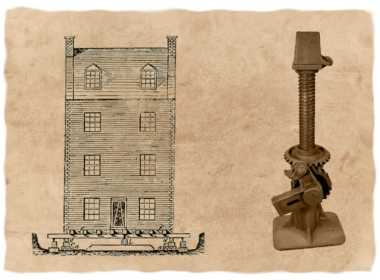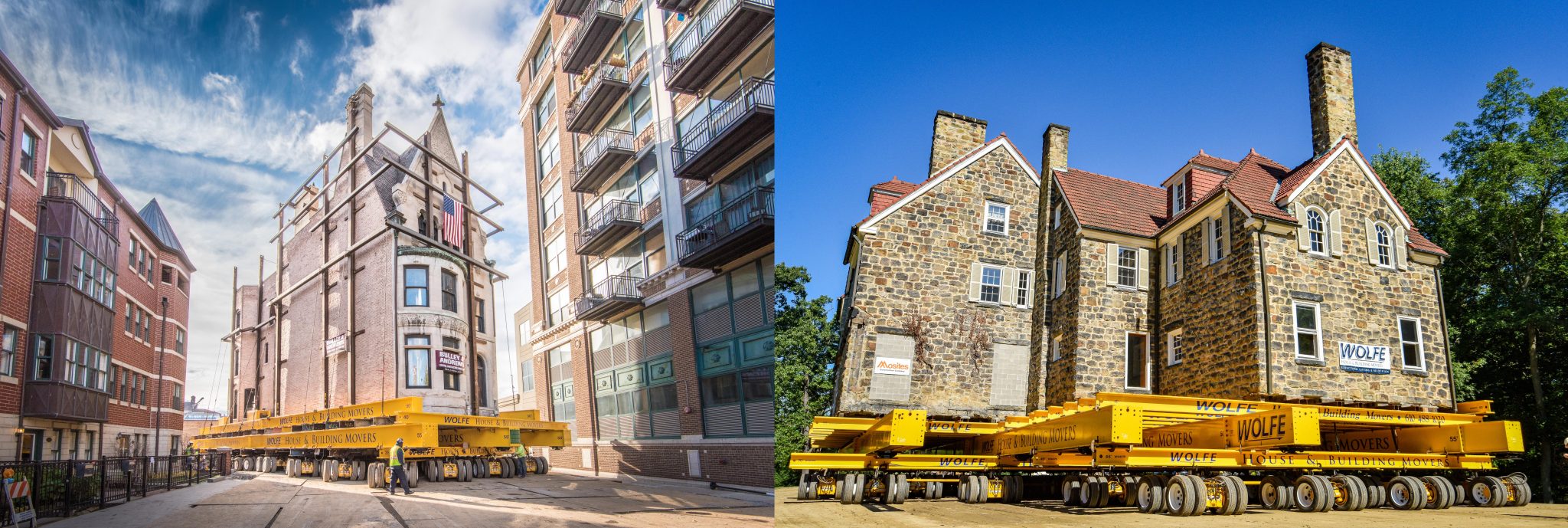In the Media
- News,
The History of House Moving

The History of House Moving
The process of moving a building is not a new one, nor is it a simple challenge to tackle. The act of moving a structure in the past was viewed as a last resort to save it from demolition. Over the last few decades with technological improvements to the process, this mindset has shifted towards the building as a financial asset and positioning this asset into the best possible scenario to gain a return on the investment. Regardless of the difficulties involved, structures have been moved in the United States since the early 1700s.
No Gain Without Pain (1700s-Early 1800s)
A big part of why moving a structure in the past was viewed as a last resort, was largely due to the delicacy of buildings and the available equipment to pull off such a feat. 18th century Americans were not afforded the luxuries we have today with hydraulic jacking systems and dollies, instead, they used wooden carriage systems and a team of horses or oxen. Community pride and preservation of a town’s history is a central reason for structural moving today, and it could arguably be said it was even more important during the 1700s as there were fewer buildings.

A wooden carriage system, a team of horses pulling a house, and a farmer moving his house in the 18th century.
Moving structures with teams of oxen or horses presented potential issues to the structural integrity of the buildings. Several building moves in the early 1800s were known to have their chimneys collapse within the first few yards of moving due to the varying force created by the animals. The necessary force and the precision to move and stop a structure at a specific location continued to be a challenge even after the advancement and adoption of locomotive powered rail systems. Housing material preferences were also making a change over this time from wood frame homes towards brick structures for those who could afford it. These buildings required additional care and bracing during a move, as they could shift, crack, or become damaged during the journey.
Movers and Shakers (1800s -1900s)
The original purpose of moving a structure to a new location can be greatly diminished if the move causes significant damage to the building. The inconsistent or uneven force applied to a structure during a move will often lead to damage of some kind. Screw jacks became a popular solution to this concern during large structural moves in the early and mid 19th century. Houses supported by wooden logs at its base would rest on steel beams that were greased and served as a “track” for the move process as the screw jacks push the base in unison. This provided an equal amount of force exerted on multiple points of the structure’s base and decreased the potential damage done to the building during the relocation phase.

Shown is an 1830’s house using the steel beam track system, that was moved by multiple screw jacks in unison along the greased beams.
As time progressed, so too did the possibilities of not only moving a structure horizontally but also raising it vertically. Elevation of a house brought multiple benefits, including prevention of possible water damage to the basement and living area, spacious views above the terrain and vegetation, and the ability to add a full basement underneath the first floor. Whether it was lifting the house at its current location, or moving the building up a steep hillside, the option to raise a house opened up new possibilities.

The Captain Samuel Brown Mansion was elevated up a steep hillside in Pittsburgh, PA of 1903. The 160-foot elevation project was made possible by steel beams and wooden cribbing, these are similar materials and methods still used today.
Hauling History (Present Day)
Horsepower gave way to steam-powered locomotives and eventually, the hydraulic jack became the most efficient and capable means of moving and lifting structures. One of the most prominent structural moves of the 21st century was the relocation of the Alexander Hamilton National Memorial House in New York City by Wolfe House Movers in 2008. The National Park Service chose Wolfe House Movers due to the ability to keep the Historic building in one piece, which thereby kept the structural integrity in place as well as preserving its historical significance. The project presented unique challenges with a church next to the house extending a large stone porch out in front of the Hamilton house. The house was raised 38 feet above the porch, moved out onto the street, and lowered back down by the use of hydraulic jacks, wooden cribbing, and steel beams. Once on the street, the 200-ton building was transported by remote-controlled hydraulic dollies to its new location at St. Nicholas Park. This project helped to highlight how hydraulics can lessen the structural damage to a historic building, while also transporting it promptly compared to older methods used in the past.

The Grange house was the only home Alexander Hamilton ever owned and was moved through New York City by the use of synchronized hydraulic systems.
In the current state of the structural moving industry, the metal rails used extensively in the 1900s are no larger necessary for many moving projects. In 2014, one of the Heaviest Houses moved in U.S. History took place in Chicago, IL by Wolfe House & Building Movers. The Historical Rees House weighed a total of 1,050 tons with the steel framing supporting the structure and was moved remotely with a hydraulic system consisting of 29 dollies and 232 rubber wheels. While this type of move doesn’t happen every day, the process of saving historic homes from demolition to pave way for new structures or roadways is a frequent request. As the national population continues to increase, the preservation of historical buildings is becoming a growing concern for many as the demolition of our architectural history continues to happen far too often for larger, more modern structures.

The Historic Rees House being moved in Chicago and the 1,600-ton masonry Walker Mansion moved in Pennsylvania in 2016.
Even weight distribution made possible by synchronized hydraulic systems has lessened the concern about any structural damage during a moving project. Heavy buildings such as the Walker Mansion weighing in at 3.2 million pounds is even possible with the proper hydraulic system. Creative solutions are also more widely available for challenging moves such as taking a building across the water on a barge or airlifting a smaller building by helicopter. Flooding of homes near shorelines, lakes, rivers, and creeks have always been an issue for the foundation and structural integrity. Homeowners are turning towards raising homes and moving them further from the water source, as they seek to prevent future flooding of their investment. However, it is important to remind ourselves that buildings are not solely viewed from a financial perspective.
As buildings continue to age and new trends evolve, the option of demolishing historical buildings that bring a sense of atmosphere to our communities is rarely viewed as a positive step. The emotional connection people have to buildings and the importance of preserving our past has become increasingly important over the last few decades. After all, the process of structural relocation will continue to be crucial as more of our architectural history is sought to be preserved for future generations.
